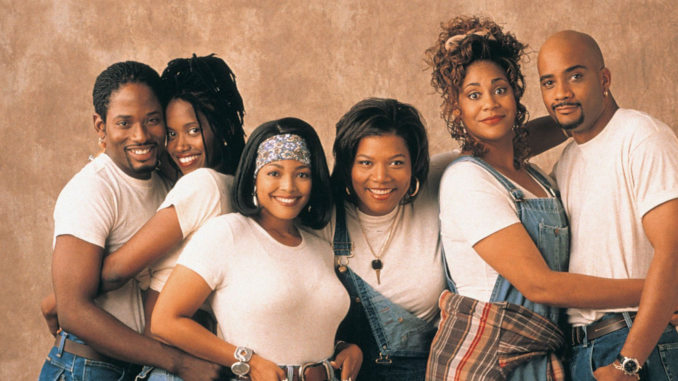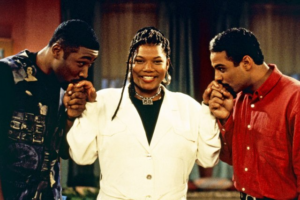
Introduction: The Lasting Impact of “Living Single”
“Living Single,” a groundbreaking sitcom from the ’90s, wasn’t just about laughter—it was about showcasing the power, intelligence, and resilience of Black women. The show’s portrayal of friendship, career ambition, love, and self-discovery offered a refreshingly honest representation of Black women living in New York City. But beyond the laughs and romance, “Living Single” holds a deeper legacy—one rooted in Black feminism, self-love, and sisterhood.
This article dives into the heart of why “Living Single” remains a classic, and how the show gave voice to a new kind of Black womanhood. From the complex relationships between the characters to their unapologetic pursuit of their dreams, “Living Single” redefined what it meant to be a Black woman on television. Here’s how we can all still relive the Black, feminist magic of “Living Single” and why the show continues to be a touchstone for empowerment and representation.
1. Strong, Independent Women Who Didn’t Apologize for Their Ambition
One of the most powerful aspects of “Living Single” was how it showed women being unapologetically ambitious. The main characters—Khadijah, Maxine, Regine, and Synclaire—were all chasing their dreams, from running a magazine to making a name in the legal field. What made their pursuit of success especially unique was that it was about more than just their careers; it was about claiming their space in the world and rejecting the limitations that society often places on women, especially women of color.
Khadijah James (Queen Latifah) was a boss in every sense of the word. She ran her own magazine, Flavor, and stood as a role model for entrepreneurship. Maxine Shaw (Erika Alexander), a fierce attorney, made it clear that she wasn’t just good at her job—she was in control of her life. These characters represented the power of being fiercely independent while also staying grounded in their roots.
2. The Show’s Fearless Approach to Female Friendships
“Living Single” isn’t just about individual achievements; it’s also about the power of female friendship. The relationships between Khadijah, Maxine, Regine, and Synclaire created a space where women uplifted each other through highs and lows. Whether it was supporting each other’s career moves or navigating complicated romantic relationships, these women had each other’s backs—always.
What stood out was how each woman had her own distinct personality and journey, yet together they formed a tight-knit sisterhood that was unstoppable. Their friendship was a constant reminder of the importance of women empowering women, especially in a world that often pits women against one another.
3. Telling Unapologetically Black Stories with Humor and Heart
“Living Single” didn’t shy away from addressing real-life struggles that Black women face. From issues of identity and representation to the challenges of love and family dynamics, the show blended humor with serious commentary. Maxine Shaw, in particular, was an unapologetic, bold, and honest character whose interactions provided the perfect balance of wit and wisdom.
The series delved into topics like Black feminism, economic independence, relationships, and mental health, all while keeping the audience laughing. “Living Single” offered viewers stories that weren’t just entertaining—they were relatable and real, reflecting the complexity of Black womanhood.
4. Representation of Diverse Personalities and Experiences
Each character on “Living Single” embodied different aspects of Black womanhood, giving audiences a broad spectrum of experiences to connect with. Khadijah was the career-driven, grounded friend; Maxine was the sassy, confident lawyer; Regine was the fashion-obsessed, romantic idealist; and Synclaire was the sweet, quirky dreamer. Together, they represented the full spectrum of what it means to be a Black woman with ambition, humor, and heart.
In contrast to many shows of the time, “Living Single” didn’t just feature stereotypical characters. Instead, it embraced the nuances of its characters’ identities and gave them space to evolve. These women were more than just their jobs, appearances, or relationship status—they were complex, multi-dimensional individuals navigating life in the best way they knew how.

5. Normalizing and Celebrating Single Women
While many sitcoms of the era revolved around couples or family dynamics, “Living Single” placed its single characters at the center of the narrative. The show normalized the idea of single women thriving on their own terms and showed that being single didn’t mean being incomplete or lonely.
Khadijah and Maxine were prime examples of women living fulfilling lives as single women in their 30s, excelling in their careers and enjoying their personal lives. The show gave audiences a refreshing look at the choice to be single—something that wasn’t often portrayed in a positive light on television at the time.
6. The Show’s Representation of Love on Black Women’s Terms
“Living Single” also tackled romantic relationships, but it did so in a way that centered the Black woman’s experience. The women on the show didn’t need to be “saved” or “fixed” by men. Instead, the men were often a supporting part of their story, rather than the central focus. Maxine Shaw and Kyle’s on-again, off-again romance is a perfect example—both were strong-willed individuals who wanted different things but were able to find common ground.
Even when the show touched on romantic conflicts, it always emphasized the importance of self-love, independence, and setting boundaries. It allowed Black women to see that their worth wasn’t tied to having a partner, but rather to their own inner strength.
7. The Significance of Black Feminism in Mainstream Media
“Living Single” was one of the first mainstream TV shows to portray Black feminism in a way that felt authentic and relatable. Black feminism isn’t just about advocating for women—it’s about advocating for justice, equality, and empowerment while acknowledging the intersectionality of race, gender, and class. Through its strong, independent women, “Living Single” embraced these ideals in a natural and accessible way.
The show didn’t try to fit into any mainstream narrative. It allowed the characters to express themselves authentically while dealing with real-world challenges faced by Black women, making it a milestone in the portrayal of Black feminism on TV.
8. The Power of Humor and Heartfelt Moments
At its core, “Living Single” was a comedy, but it never shied away from touching on serious issues like career challenges, family dynamics, and the struggles of being a Black woman in a predominantly white world. The show tackled important social issues through humor, never losing its comedic charm while providing valuable lessons on navigating life.
It balanced laughter with heartfelt moments, showing that Black women were not only capable of thriving professionally but also of having deep, meaningful relationships with themselves and others.
9. Breaking the Mold of Traditional TV Roles for Black Women
Before “Living Single,” Black women on TV were often relegated to secondary or stereotypical roles. But with Khadijah, Maxine, Regine, and Synclaire, the show defied expectations. These characters weren’t just there for comic relief—they were the lead roles, representing the multifaceted, complex lives of Black women in all their glory.
In a time when representation was limited, “Living Single” carved out a space where Black women could be seen as strong, ambitious, funny, and, most importantly, worthy of a leading role in their own stories.
Conclusion: Relive the Magic of “Living Single”
“Living Single” may have aired its final episode decades ago, but its relevance has only grown over time. The show’s Black feminist magic continues to resonate because it portrayed empowered, independent, and multidimensional Black women in a way that was groundbreaking for its time.
Whether you’re rediscovering the show for the first time or revisiting it for the hundredth, it’s a reminder of how much power, humor, and love can come from telling our own stories. Living Single proved that Black women deserve their own narrative, and that narrative is filled with strength, laughter, and endless possibilities. If you haven’t already, it’s time to relive the magic—and if you have, there’s always more to discover.
FAQs
1. How did “Living Single” change the portrayal of Black women on TV?
“Living Single” was a trailblazer by offering a fresh perspective on Black womanhood. It gave Black women complex, multifaceted roles, focusing on their careers, relationships, and personal growth, all while rejecting traditional stereotypes.
2. Why is “Living Single” considered a feminist show?
The show highlighted women pursuing their dreams, being financially independent, and forming deep friendships with each other. It centered on Black women’s empowerment, tackling issues like work-life balance, love, and sisterhood.
3. What was the significance of the show’s portrayal of friendship?
The close-knit friendship between the main characters showcased the power of female solidarity and support. They helped each other grow, succeed, and overcome personal challenges, making their bond a key element of the series.
4. How does “Living Single” address relationships?
“Living Single” portrayed relationships from a Black feminist perspective, showing women who were complete on their own and seeking relationships that enhanced, rather than defined, their lives.
5. Can I watch “Living Single” today?
Yes! “Living Single” is available for streaming, allowing new audiences to experience its magic while older fans can revisit the show and enjoy its timeless appeal.
